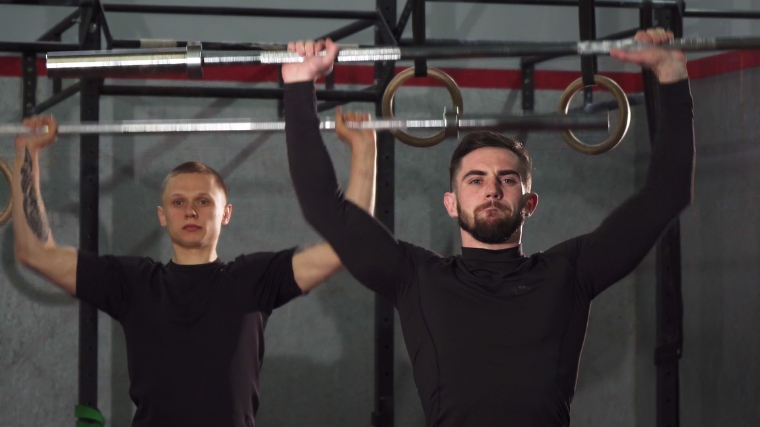Sometimes, even the most dedicated CrossFitters want to get in and out of the gym as quickly as humanly possible. Enter a benchmark workout truly designed for speed: Grace. The CrossFit Grace workout is one of the fastest WODs (workouts of the day) around. All you need is a barbell, some plates, and a heaping helping of determination.
Picture this: one weightlifting movement, 30 reps, going as fast as you can. Since it debuted on the CrossFit website in 2004, Grace was always meant to be a race against yourself. And while you might not be moving your feet anywhere, you’ll be sprinting to beat the clock.

Here’s everything you need to know to make quick work of the Grace benchmark workout. Dust off your clean & jerk skills — you’ll need them.
- What Is the Grace Workout?
- What Are Good Grace Times?
- Strategies for the Grace Workout
- How to Scale Grace for Beginners
- How to Scale Grace for Intermediates
- How to Scale Grace for Advanced Athletes
Editor’s Note: The content on BarBend is meant to be informative in nature, but it should not be taken as medical advice. When starting a new training regimen and/or diet, it is always a good idea to consult a trusted medical professional. We are not a medical resource. The opinions and articles on this site are not intended for use as diagnosis, prevention, and/or treatment of health problems. They are not substitutes for consulting a qualified medical professional.
What Is the Grace Workout?
The CrossFit workout Grace consists of 30 reps of one exercise — the clean & jerk — performed as quickly as possible. You’ll clean the barbell off the ground and transition as smoothly as possible into a jerk. Repeat for 30 reps, moving as quickly as you can to score the fastest time.
Grace is a weightlifting WOD that demands a high level of barbell skills, strength, endurance, and cardiovascular capacity. The workout is meant to happen in the blink of an eye, but that doesn’t mean it’ll be easy. Your entire body will work tremendously hard throughout this WOD, with no real breaks coming for any muscle group until you hit rep 30.
The Workout
Grace is not a WOD to be trifled with — but it’s extraordinarily uncomplicated on paper. Here it is, in all its simplistic glory.
For time:
- 30 Clean & Jerks
Women: 95 pounds | Men: 135 pounds
Athletes of any gender can scale the weight they’re using as needed. If the RX (prescribed) weight is above or near your one-rep max, for example, you’ll need to significantly lighten the load.
What Are Good Grace Times?
From CrossFit legend Noah Ohlsen to famous strongman Laurence “Big Loz” Shahlaei, plenty of athletes have performed Grace in smoking fast times. Especially when an athlete hits under that minute mark, you know that something powerful is happening.
[Related: Noah Ohlsen Unofficially Breaks World Record Time For CrossFit Benchmark Workout Fran]
On the other hand, if it takes you more than five minutes to perform Grace, don’t panic. Weightlifting efficiently is a skill that takes a long time to develop, and you’ll have to practice a lot. You might also need to use less weight or even modify some aspects of the movement to better suit your current skill and experience level.
- Elite: Less than 1:30
- Advanced: Between 1:30 and three minutes
- Intermediate: Between three and five minutes
- Beginner: More than five minutes
Strategies for the Grace Workout
While Grace might seem simple, you need a solid strategy to emerge successful on the other side of the start clock. Here’s how to get yourself a faster Grace time.
Warm Up
If you’re performing it at the appropriate difficulty level, Grace shouldn’t take more than a few minutes. It might seem strange to warm up for a bout of activity that’s not going to last much longer than your favorite song, but you don’t want to go into Grace cold.

Instead, perform a few cat cows, deep squat rotations, and empty barbell or PVC pipe clean & jerks. The goal here is to get your heart pumping harder and to prepare your body (and mind) for intense action. Push hard enough to start focusing, but don’t fatigue yourself — you’ll be plenty exhausted after the actual WOD begins.
Clean Up Your Technique
You don’t get better at Grace only by performing Grace. If improving this benchmark is important to you, spend time improving your clean & jerk technique in your skills training and other CrossFit workouts.
This means practicing the lift itself so that you can work on timing, speed, and the nuances of positioning and technique. It also means improving your thoracic and overhead mobility to lubricate the jerk component of this workout. Work on your hip and ankle mobility to improve the squat portion. And for your front-rack position, develop that wrist and shoulder mobility.
Dedicate the time you need to practice clean & jerks and develop the mobility you need to perform them efficiently. As you become a more efficient lifter, you’ll become a faster lifter who can move heavier weight.
Avoid Failure
You want to work hard during your benchmarks, but in this case, you don’t want to reach failure. If you approach failure anywhere before 30 reps, you’re setting yourself up for an unnecessary struggle. By coming out too hot, you’ll likely burn out your muscles and lungs before you can reach your potential if you’d paced it more wisely.

Instead, proceed with a plan on how to break up your reps. While very advanced and elite-level athletes might push through unbroken, if you’re just starting, consider breaking the workout up into sets of five, six, eight, or 10 reps. Just be sure to keep a careful count in your head.
How to Scale Grace for Beginners
Whether you’re new to CrossFit, new to weightlifting movements, or just have never done this particular benchmark before, embrace your newbie status. Here are some modifications that newcomers to Grace might want to deploy.
Use Dumbbells or Kettlebells
The barbell clean & jerk requires a tremendous amount of mobility and technique. One way to make the movement a bit easier for beginners is to simply use dumbbells or kettlebells instead.
A barbell is a bilateral implement that will lock both of your arms into the same path. The unilateral movements afforded by kettlebells and dumbbells give you the grace to be a little bit looser with your form.

You won’t need the same level of shoulder mobility to press kettlebells overhead as you do with a barbell, for example. And your wrists certainly won’t be under such extreme demand when you’re using cleaning dumbbells as opposed to a barbell. Swap out the implement to give yourself a similar stimulus with a more accessible mechanism.
Do Cleans Only
Some athletes may be unable to perform overhead presses during Grace. This might be because they’re recovering from an injury. An athlete might also just not have the requisite shoulder strength or endurance yet to perform 30 overhead reps for time.
In this case, try performing 30 cleans only. You can focus on your clean technique while not getting quite as winded as you may with both components of the lift. Only working on cleans also gives you the time and opportunity to build your shoulder muscles to perform the jerk component of this benchmark eventually.
Do Presses Only
Performing Grace with presses only won’t quite give you the same training stimulus. You will likely get winded, but the cardiovascular demand won’t be as high as it will be with all that cleaning and squatting.
Still, you might be looking to focus on your pressing technique. Or you might just not have the cardiovascular capacity to perform such an intense exercise for 30 fast reps. As you’re working to develop these things, perform the pressing parts of Grace.
How to Scale Grace for Intermediates
Once you’ve mastered the barbell clean & jerk, you’re ready to approach the Grace benchmark head-on. It was written with a barbell, and you’ll be able to perform it with a barbell soon enough.
Use an Empty Barbell
Before you slide on the bumper plates, practice Grace with an empty barbell. This will help you identify any lingering flaws in your form that will cause more significant problems when the load is heavier.
By performing Grace with an empty barbell, you’re not only scaling the weight for the sake of load reduction. You’re also making sure that you’re doing the workout the right way, with excellent form and as much efficiency as possible. When you’re more efficient with your movements, you waste less energy. That translates into faster (and heavier) lifts.
Scale the Weight
This is perhaps the most common way to scale WODs to make them more accessible. The lower Rx weight here is 95 pounds. But while you may be an intermediate-level CrossFitter, 30 reps is a lot of work — 95 pounds may just be too heavy to reasonably manage there.

Whatever your specific circumstance, don’t be ashamed to reduce the weight to use something lower than what’s on the whiteboard. Start more conservative than you might think you need to.
This might mean sticking with the empty barbell for the time being, or it might mean sliding on those little five-pound plates and nothing more. The worst that can happen is you’ll clock a faster time than expected. You can always move up in weight the next time you do this benchmark.
How to Scale Grace for Advanced Athletes
Advanced athletes may hit roadblocks in their training, such as injuries and other movement limitations. So even if you’re advanced, you may find yourself scaling back weight or even using dumbbells instead of a barbell.
But if you’ve got Rx Grace under your belt, it might be time to scale up.
Heavy Grace
If the CrossFit greats know how to do one thing, it’s taking an already difficult WOD and making it even tougher. Two-time CrossFit Games podium-finisher Sara Sigmundsdóttir has scaled Grace up to 220 pounds and locked out all 30 reps.
Five-time Fittest Man on Earth® Rich Froning has also famously performed Grace with two plates. CrossFit legend Brooke Wells crushed a 155-pound Heavy Grace in 3:18 when she was still only two years into her Games career.
[Related: The 8 Best Supplements for CrossFit (2023 Update)]
What Heavy Grace means to you depends on your current strength and endurance level. Maybe 125 pounds is heavy for you, and maybe 225 pounds is heavy. Whatever the case may be, jot down what weight you’re bringing to Heavy Grace so that the next time you do it, you can compare your results accurately.
More on CrossFit Training
The CrossFit Grace workout isn’t easy. But if you head into your workout prepared, you’ll be setting yourself up for a faster time. Go in with a plan of how you’re going to break up your reps and make sure you’re practicing your mechanics outside of the WOD. You’re sure to improve your time soon.
Now, you know everything you need to about how to perform Grace to the best of your ability. It’s time to improve all your benchmark workouts by checking out BarBend’s other CrossFit benchmark guides.
- The CrossFit Cindy Workout Explained and Scaled for Every Skill Level
- The CrossFit Angie Workout Explained and Scaled for Every Skill Level
- The CrossFit Fran Workout Explained and Scaled for Every Skill Level
Featured Image: Lenar Nigmatullin / Shutterstock